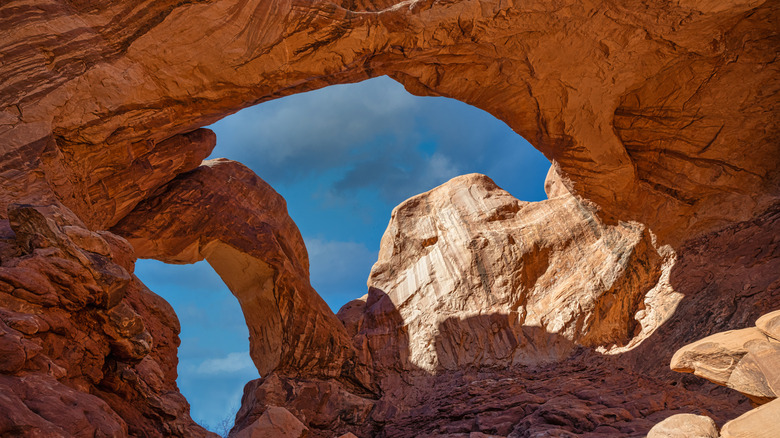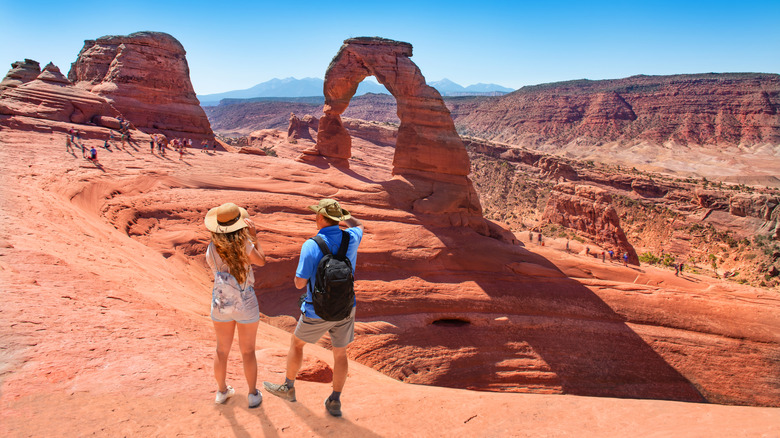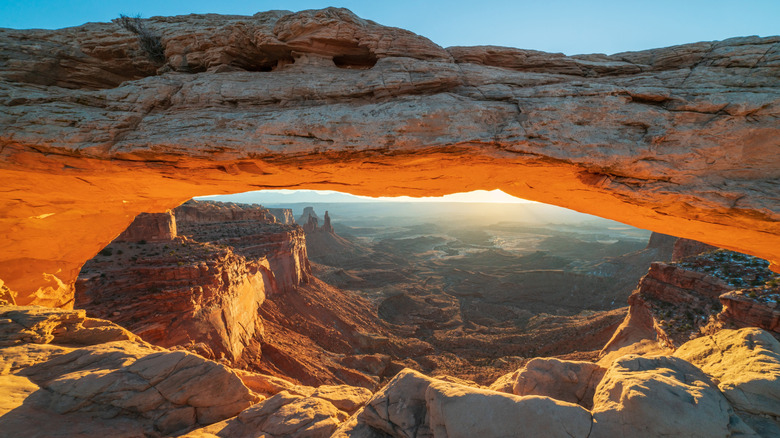Utah's Breathtaking Natural Arches Won't Last Forever (And Why That's Okay)
Towering rock spires and sandstone arches so tall that they're visible from miles away are instantly recognizable features of the American West. The wide open desert spaces dotted with geological wonders inspire awe, sprawling across multiple states. These natural arches are found prolifically throughout Utah's "Mighty Five" national parks: Arches, Zion, Bryce Canyon, Canyonlands, and the impressive Capitol Reef. These have long been landmarks of history, optimism, and adventure, serving as spiritual hubs in Indigenous traditions and used as movie backdrops for films like "Thelma and Louise," "Indiana Jones and the Last Crusade," and even the outer-space caper "Galaxy Quest." Not to mention, they make for breathtaking road trip destinations.
However, in 2024, one widely recognized arch in Glen Canyon National Recreation Area's Lake Powell — nicknamed the Toilet Bowl for its resemblance to, well, a commode — collapsed, leaving a heap of crumbled sandstone. The double arch was an iconic landmark in the lake and believed to be formed from Jurassic-era Navajo sandstone that was millions of years old. The destruction was shocking, but it wasn't the first magnificent arch to topple. In 2008, campers in the Devils Garden area of Arches National Park heard rumbling in the middle of the night and found that Wall Arch, the 12th largest arch in the park, had collapsed under its own weight.
In both cases, slow erosion from water and wind contributed to the structures' demise, but experts speculate these have been exacerbated by human activity — especially heavy visitor traffic to the parks — and subsequent climate changes have increased the likelihood of recurrence. A concerned public now wonders: Are all the arches in danger of falling, and is the National Parks Service going to do anything about it?
Natural erosion and high volumes of visitors affect the desert landscape
The arches looming high in the desert were once buried under layers of sediment. Over eons, snow has melted and glacier have thawed, breaking rocks, smoothing "fins," and creating cliffs. The sandstone was (and continues to be) pulled, warped, fragmented, and eroded into shape. Sandstone is a very lightweight, porous material, held together through minerals that act as a cement to keep it all together. When weather or groundwater erodes this material, it eventually reaches total deterioration and gravity takes over. As the National Parks Service describes, "It's a bit like sucking on a mint or a candy cane: it slowly dissolves in your mouth but will usually break up into pieces before it's completely gone."
Geological studies have also determined that the arches and formations constantly vibrate internally, as subtle tremors help geologists monitor the formations' stress levels, but those tremors have increased with human activity. The American West has also endured a megadrought for decades, evaporating water and drying out soil at a very quick rate, creating potential for sink holes and dust storms.
While all of this should raise some alarms around human behavior and ways in which we address climate change, it may not be all bad news. This is, after all, geology in action, as the cycle of lifespans that evolves structures and species is constantly changing. Erosion created the arches and erosion erases them, though from a human perspective it's jarring to witness large-scale shifts of something that tends to happen so slowly and microscopically over generations. Karen Garthwait, a spokesperson for Arches and Canyonlands national parks, says, "Our mission is to preserve the natural processes that create these structures, which of course, is the same process that will eventually undo them as well" (via the Associated Press).
The National Park Service's response to geological changes
In response to witnessing changes to the landscape and rockfall throughout the years, park officials once considered wrapping the sandstone arches in plastic to help preserve them. The idea was eventually abandoned, but it still took decades before the park made simple moves to protect the arches' longevity from human interference. In 2006, after a climber scaled Delicate Arch and left rope grooves in the sandstone, the park cracked down on climbing these natural wonders.
The sandstone arches are an aesthetic fixture that may seem immovable, enduring beyond the scope of generations. Years of wind and water have carved and polished these natural wonders, but those same years of wind and water have also eaten away at the sandstone, eroding it down into dusty granules that will eventually crumble. Jeffrey Moore, a geologist at the University of Utah, tells AZ Central, "We anticipate that arches will ultimately fall ... they are transient landforms, ever-changing and sometimes failing."
In the end, as the old adage proclaims, time waits for nobody — and that includes ancient geological wonders. If you get the chance to visit this area of the U.S., take an unforgettable road trip through Utah's Mighty Five national parks to see some of the arches for yourself. Enjoy them as they are now, not as they have not always been nor always will be.


